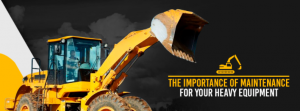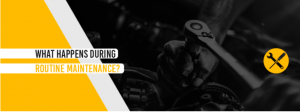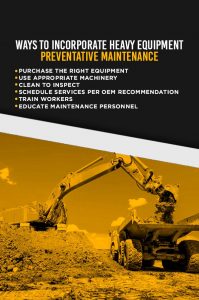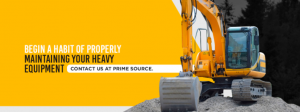
You need to keep your heavy equipment running smoothly and predictably to avoid work delays. For the sake of your fleet, you cannot skimp on maintenance. In fact, keeping up with the operation of your construction equipment is almost as important a task as using it. Without proper care, your heavy machinery won’t be available when you need it to be.
Jump to Section
- Why Construction Equipment Maintenance Is Essential
- What Happens During Routine Maintenance?
- What Is Preventative Maintenance?
- Preventative vs. Predictive Maintenance
- Reasons for Preventative Maintenance
- Why Preventative Maintenance Is Important
- Ways to Incorporate Heavy Equipment Preventative Maintenance
- How Technology Can Improve Maintenance
- Begin a Habit of Properly Maintaining Your Heavy Equipment
Why Construction Equipment Maintenance Is Essential

Maintenance comes in two forms — reactive and preventative. Reactive maintenance occurs when your equipment encounters a problem such as low oil levels or performance problems from contaminants in the fuel. Though the machine may not completely break down, it will still experience enough problems to require service before it can work at its greatest efficiency. Often, reactive maintenance occurs after a breakdown happens, requiring a rapid response to the challenge to minimize downtime.
While this type of maintenance will get your equipment back into operation, you shouldn’t react to problems all the time. Doing so will stop work with the nonfunctional machine until it gets fixed. Depending on the severity of the problem, this repair time could take away hours or days from your project. Instead of waiting for parts of your fleet to go out of commission, consider taking a more proactive approach through preventative maintenance.
Regularly servicing your heavy equipment will help keep it in peak condition. Preventative maintenance should be your preferred strategy because in the construction industry, running equipment to the point of failure creates more problems than the minor inconvenience of scheduled maintenance. You’ll also save time and money if you service your construction equipment before it loses efficiency and performance.
What Happens During Routine Maintenance?
Reactive maintenance tasks occur when a problem begins to present itself. Reacting to the issue requires finding the cause and fixing it. Low oil, reduced fuel quality and clogged filters often cause problems if left unchecked. If a problem arises, checking the rest of the vehicle for growing concerns should become a part of involved chores.
The exact maintenance chores will depend on the vehicle and the manufacturer’s recommendations. However, most pieces of heavy equipment have engines that need similar checks performed on them. For regular maintenance of your heavy machinery, check the:
- Oil: Verify that the system has enough oil and that the oil’s quality is acceptable.
- Fluid levels: Look at the coolant, oil, fuel and other fluid levels to see if they’re high enough. Frequent drops in fluids indicate a leak somewhere that you must repair.
- Functioning: Do all the parts move as smoothly as they should? Do the controls respond appropriately? Problems with these elements could indicate issues with the accessory operators on the equipment.
- Appearance: During this visual inspection, looking for anything that appears out of place can make finding problems easier.
What Is Preventative Maintenance?
Preventative maintenance occurs on a schedule regardless of whether the equipment shows problems operating or not. By integrating a regular inspection into your company’s repair and maintenance schedule, you’ll ensure that the machinery will not have to stop working before it receives attention. The result will be an increase in uptime and productivity. With many factors that can cause lost time on construction projects being outside your control, such as inclement weather, maintaining your fleet is one valuable thing to remember if you want to prevent lost time.
Scheduling regular maintenance also includes performing frequent cleaning. In fact, the notion of “clean to inspect” is a critical idea in preventative maintenance. Any cleaning task of heavy equipment should also include a visual inspection to check for potential problems that could be in development.
While preventative servicing equipment will not stop all breakdowns from occurring, it can reduce their number, which is one part of the importance of preventative maintenance. To take this type of service to the next level, you may consider predictive maintenance. Though related, both have distinct factors that will make one better for your fleet’s needs.
Preventative vs. Predictive Maintenance
Preventative service occurs on a set schedule regardless of the immediate needs of the machinery. It serves to look for factors that could indicate deterioration in the equipment while checking refillable or replaceable items on the device.
Predictive maintenance happens when monitoring equipment shows the need for maintenance to occur. Depending on the age of your fleet, you may need predictive maintenance less often than preventative services. As your equipment ages though, services likely increase in frequency since older machinery will require more regular repairs. You’ll need to keep accurate records of your service schedule and install monitoring devices on your equipment if you choose these methods.
Using information from monitoring devices, you’ll decide the best times to service your fleet based on each machine’s functioning. Instead of conducting regular inspections, the monitoring equipment will do the job for you. This method of repairing a fleet is one way innovations in technology are making maintenance more efficient.
If you want a lower-tech approach, scheduling service for your fleet at regular intervals will suffice. However, be prepared to adjust the schedule, especially for older equipment, if you notice the machinery has greater wear at each ensuing service time. The more wear your heavy equipment shows, the more often it will need inspections and service.
Preventative maintenance may occur after a set number of usage hours or mileage. This schedule ties the service into the equipment’s use and requires records of how long your workers use the equipment, and it does not take into account conditions that could put more strain on the machine. For instance, running motors in freezing temperatures puts a strain on the battery, and hot temperatures can make motors more likely to overheat if they’re not properly cooled. After use in extreme conditions, your equipment may provide better service if you apply predictive maintenance.
Reasons for Preventative Maintenance
Yes, preventative maintenance can take time from operations. However, the reasons behind caring for your fleet’s vehicles will make the time investment worthwhile. Keeping up with the care of your fleet will help make the equipment safer, save money, reduce downtime and more. With so many benefits of preventative maintenance, this time investment is one that you cannot forego. Some of the benefits of preventative maintenance include that it:
- Saves money: Maintenance can save up to 40% of cost overrun on construction projects by improving operations and productivity of machinery. Additionally, improperly cared for engines could see a decrease in fuel efficiency, raising the amount you spend on fuel to complete a project. Keeping the system at its peak by replacing filters and keeping the machinery serviced will prevent this situation.
- Improves safety: With regular maintenance, workers retain the operation of safety mechanisms on the equipment, protecting them from harm on the job. A machine that suddenly stops working with an operator on board could put the employee at risk of injury from the sudden change.
- Ensures efficiency: Stopping work to make repairs uses precious working hours, increasing the total time to complete the job and reducing efficiency. Well-maintained construction equipment will work throughout the project, reducing downtime.
- Preserves warranty effectiveness: For some warranties, neglecting basic service tasks could void the protection of the policy.
- Protects insurance coverage: Depending on the details of your fleet’s insurance, damage caused by neglecting maintenance may not have coverage.
- Prevents breakdowns: Breakdowns waste your workers’ time. Regular maintenance prevents such events from occurring by keeping up with the care of your heavy equipment.
Why Preventative Maintenance Is Important
Whether you choose preventative or predictive maintenance, you must allow for regular servicing of your heavy equipment. Without it, you’ll find the usage life of your machinery dropping, efficiency declining, productivity falling and projects passing their due dates. Maintaining your equipment ensures your workers have the tools and machinery they need to get the job done quickly and efficiently.
Instead of losing productivity by reacting to issues, prevent them with scheduled maintenance. Maintaining your equipment is critical for avoiding downtime, especially because breakdowns are so unpredictable. Yes, you’ll expect to see failures as you break in a new machine as well as when it reaches the end of its usefulness. However, 80% of failures occur randomly, outside of the end-of-life and new-equipment portions of the machine’s time. Incorporating preventative service chores into your fleet’s operations can minimize the impacts of these breakdowns.
Checklists will help your workers to know what to evaluate and when. By following a checklist, workers will be less likely to forget to evaluate the important components of the system. Regardless of their experience, all maintenance personnel should use checklists to ensure they follow the correct procedures for inspecting, cleaning and fixing your heavy equipment.

Ways to Incorporate Heavy Equipment Preventative Maintenance
If your business relies on reactive maintenance, you don’t need to make drastic changes to alter your service style. You can use many methods to add to your service side to improve your maintenance program. The more of these methods you use, the better your equipment will run:
- Purchase the right equipment: Regardless of the work your business does, always purchase the correct equipment for the job. Don’t spend less to buy an undersized piece of equipment. It will wear out too soon, costing you more money over time. Choose construction equipment based on the job.
- Use appropriate machinery: Just as you must purchase the correct equipment for your worksite, your employees have to use the right machines for the job. Never attempt to use machinery not approved for a specific weight. Overburdening your equipment or improperly using it could void the warranty, put workers at risk and increase the strain on the engine and components.
- Clean to inspect: When equipment gets cleaned, the worker must thoroughly examine the machine. Ideally, during cleaning and inspection, the worker will follow a checklist to verify that they have looked over all necessary components to see if the device requires service. Anything that appears unusual should require the machine to get immediate repairs or part replacements before going back onto the jobsite.
- Schedule services per OEM recommendation: Always refer to the manufacturer’s recommendations for service schedules for your heavy equipment. You’ll find this information from the vendor or the manufacturer’s website. Approved service technicians for that brand will also know the scheduled maintenance intervals for the equipment. Don’t be afraid to ask or to outsource your maintenance to have your machinery correctly serviced.
- Train workers: Train workers in the correct use of the machines they operate. Improper use of heavy equipment can put it under excessive strain, leading to premature wear. Never allow untrained workers to operate the machinery if you hope to prevent accidents and equipment breakdowns. Operators must also receive training to recognize symptoms of issues with the machinery that may occur during use. Depending on the level of severity, the worker may need to bring the machine off the jobsite for immediate service or wait until the end of the workday.
- Educate maintenance personnel: If you have a team of workers who have only completed reactive repairs on your equipment, reeducate them on the importance of heavy equipment maintenance and how being proactive can help prevent larger problems. If needed, you may have to explain the advantages of preventative maintenance to them to ensure they know why they must conduct more services on the equipment in your fleet. If they understand why their chores are critical to your operations, they’ll be more willing to follow through.
How Technology Can Improve Maintenance

Technology can help your company by making predictive maintenance possible. Sensors, computer programs, analysis methods and more can help you determine the best time to get your heavy equipment serviced. With preventative maintenance, you could waste time and money by replacing filters or parts that still have a useful life in them. Predictive maintenance takes parts as close to failure as possible but requires you to replace them before they break.
Though predictive maintenance requires paying for the technology you want to implement, consider the long-term savings. After the initial investment in technological components needed for predictive maintenance, you can save money on maintaining your heavy equipment. One mining operation saved 13 times the cost of replacing the part by scheduling the replacement instead of waiting for a breakdown.
Data frequently used for predictive maintenance comes from a variety of sources, including:
- Telematics: Telematics devices collect information about the machinery they’re installed on and send that operating information to a computer that collects and analyzes the data. Some data may require downloading to a computer through a physical line. It will help maintenance personnel predict the best time for servicing the heavy equipment.
- Fluid analysis: Fluid analysis is another set of data software you may use to help predict service requirements. Fluids from the vehicle will get sent to a lab to determine the level of wear the system has experienced.
- Condition monitoring: Conditions on the jobsite will help computer systems decide when to schedule predictive maintenance. Harsh conditions such as snow, ice or excessive heat will require more frequent maintenance than equipment used in moderate weather.
Begin a Habit of Properly Maintaining Your Heavy Equipment
Don’t wait until a breakdown disrupts your jobsite. Schedule construction equipment preventative maintenance with us at Prime Source.
We also understand that no matter how well you care for your equipment, you’ll eventually need to make repairs. Turn to our highly experienced team of technicians to make the repairs on your heavy equipment. Should you need parts, we have those too.
Your fleet should reflect your investment in your company. Don’t let the equipment your employees operate become less efficient through neglect. You can’t afford to forego maintaining the fleet if you want the vehicles to last a long time and work well when you need them. For more information about service, maintenance or parts, contact us at Prime Source.


